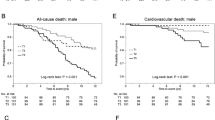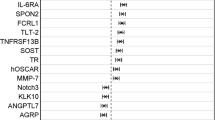Abstract
Little is known about the association between plasma concentrations of fatty acid binding protein 3 and 4 and the risk of diabetes in population-based cohorts. In a prospective nested case–control design, we studied 149 cases of diabetes and 149 matched controls from the Physicians’ Health Study. Plasma fatty acid binding proteins were measured on frozen specimens collected between 1995 and 2001 by ELISA. Cases of diabetes were self-reported and validated in a subsample via review of medical records. We used conditional logistic regression to estimate multivariable relative risks. The mean age at baseline was 64.9 years and median plasma fatty acid binding protein 3 and 4 were 2.12 ng/ml (IQR 1.62–2.66) and 15.32 ng/ml (IQR 12.14–18.73), respectively. In separate models, each fatty acid binding protein was positively associated with the risk of diabetes in a conditional logistic regression adjusting for matching variables, smoking, and hypertension. However, upon adjustment for each other, only fatty acid binding protein 4 (but not 3) was positively associated with the risk of diabetes [relative risk (95 % CI) 1.0 (reference), 2.73 (1.08–6.89), 2.66 (1.11–6.42), and 6.89 (2.83–16.80) across consecutive quartiles of fatty acid binding protein 4, P for trend <0.0001]. The FABP4-diabetes association was modified by body mass index (P interaction 0.03). Our data showed a positive association between plasma fatty acid binding protein 4 but not 3 and the risk of diabetes in US male physicians. The interaction with body mass index warrants further investigations.
Similar content being viewed by others
Abbreviations
- CI:
-
Confidence interval
- DM:
-
Type 2 diabetes
- ELISA:
-
Enzyme-linked immunosorbent assay
- FABP:
-
Fatty acid binding protein
- RR:
-
Relative risk
- SD:
-
Standard deviation
References
Wirehn AB, Andersson A, Ostgren CJ, Carstensen J (2008) Age-specific direct healthcare costs attributable to diabetes in a Swedish population: a register-based analysis. Diabet Med 25:732–737
Marchant K (2008) Diabetes and chronic kidney disease: a complex combination. Br J Nurs 17:356–361
Vijan S, Hofer TP, Hayward RA (2000) Cost-utility analysis of screening intervals for diabetic retinopathy in patients with type 2 diabetes mellitus. JAMA 283:889–896
King H, Aubert RE, Herman WH (1998) Global burden of diabetes, 1995–2025: prevalence, numerical estimates, and projections. Diabetes Care 21:1414–1431
Wild S, Roglic G, Green A, Sicree R, King H (2004) Global prevalence of diabetes: estimates for the year 2000 and projections for 2030. Diabetes Care 27:1047–1053
Flegal KM, Carroll MD, Ogden CL, Johnson CL (2002) Prevalence and trends in obesity among US adults, 1999–2000. JAMA 288:1723–1727
Howard BV, Rodriguez BL, Bennett PH, Harris MI, Hamman R, Kuller LH, Pearson TA, Wylie-Rosett J (2002) Prevention conference VI: diabetes and cardiovascular disease: writing group I: epidemiology. Circulation 105:e132–e137
Mokdad AH, Bowman BA, Ford ES, Vinicor F, Marks JS, Koplan JP (2001) The continuing epidemics of obesity and diabetes in the United States. JAMA 286:1195–1200
Kershaw EE, Flier JS (2004) Adipose tissue as an endocrine organ. J Clin Endocrinol Metab 89:2548–2556
Bagheri R, Qasim AN, Mehta NN, Terembula K, Kapoor S, Braunstein S, Schutta M, Iqbal N, Lehrke M, Reilly MP (2010) Relation of plasma fatty acid binding proteins 4 and 5 with the metabolic syndrome, inflammation and coronary calcium in patients with type-2 diabetes mellitus. Am J Cardiol 106:1118–1123
Makowski L, Hotamisligil GS (2004) Fatty acid binding proteins—the evolutionary crossroads of inflammatory and metabolic responses. J Nutr 134:2464S–2468S
Stejskal D, Karpisek M (2006) Adipocyte fatty acid binding protein in a Caucasian population: a new marker of metabolic syndrome? Eur J Clin Invest 36:621–625
Yang R, Castriota G, Chen Y, Cleary MA, Ellsworth K, Shin MK, Tran JL, Vogt TF, Wu M, Xu S, Yang X, Zhang BB, Berger JP, Qureshi SA (2011) RNAi-mediated germline knockdown of FABP4 increases body weight but does not improve the deranged nutrient metabolism of diet-induced obese mice. Int J Obes (Lond) 35:217–225
Chmurzynska A (2006) The multigene family of fatty acid-binding proteins (FABPs): function, structure and polymorphism. J Appl Genet 47:39–48
Hotamisligil GS, Johnson RS, Distel RJ, Ellis R, Papaioannou VE, Spiegelman BM (1996) Uncoupling of obesity from insulin resistance through a targeted mutation in aP2, the adipocyte fatty acid binding protein. Science 274:1377–1379
Boord JB, Maeda K, Makowski L, Babaev VR, Fazio S, Linton MF, Hotamisligil GS (2004) Combined adipocyte-macrophage fatty acid-binding protein deficiency improves metabolism, atherosclerosis, and survival in apolipoprotein E-deficient mice. Circulation 110:1492–1498
Tuncman G, Erbay E, Hom X, De Vivo I, Campos H, Rimm EB, Hotamisligil GS (2006) A genetic variant at the fatty acid-binding protein aP2 locus reduces the risk for hypertriglyceridemia, type 2 diabetes, and cardiovascular disease. Proc Natl Acad Sci USA 103:6970–6975
Simon I, Escote X, Vilarrasa N, Gomez J, Fernandez-Real JM, Megia A, Gutierrez C, Gallart L, Masdevall C, Vendrell J (2009) Adipocyte fatty acid-binding protein as a determinant of insulin sensitivity in morbid-obese women. Obesity (Silver Spring) 17:1124–1128
Hsu BG, Chen YC, Lee RP, Lee CC, Lee CJ, Wang JH (2010) Fasting serum level of fatty-acid-binding protein 4 positively correlates with metabolic syndrome in patients with coronary artery disease. Circ J 74:327–331
Xu A, Wang Y, Xu JY, Stejskal D, Tam S, Zhang J, Wat NM, Wong WK, Lam KS (2006) Adipocyte fatty acid-binding protein is a plasma biomarker closely associated with obesity and metabolic syndrome. Clin Chem 52:405–413
Tso AW, Xu A, Sham PC, Wat NM, Wang Y, Fong CH, Cheung BM, Janus ED, Lam KS (2007) Serum adipocyte fatty acid binding protein as a new biomarker predicting the development of type 2 diabetes: a 10-year prospective study in a Chinese cohort. Diabetes Care 30:2667–2672
(1988) Findings from the aspirin component of the ongoing Physicians’ Health Study. N Engl J Med 318:262–264
(1989) Final report on the aspirin component of the ongoing Physicians’ Health Study. Steering Committee of the Physicians’ Health Study Research Group. N Engl J Med 321:129–135
Christen WG, Gaziano JM, Hennekens CH (2000) Design of Physicians’ Health Study II—a randomized trial of beta-carotene, vitamins E and C, and multivitamins, in prevention of cancer, cardiovascular disease, and eye disease, and review of results of completed trials. Ann Epidemiol 10:125–134
Sesso HD, Buring JE, Christen WG, Kurth T, Belanger C, MacFadyen J, Bubes V, Manson JE, Glynn RJ, Gaziano JM (2008) Vitamins E and C in the prevention of cardiovascular disease in men: the Physicians’ Health Study II randomized controlled trial. JAMA 300:2123–2133
Djousse L, Khawaja O, Bartz TM, Biggs ML, Ix JH, Zieman SJ, Kizer JR, Tracy RP, Siscovick DS, Mukamal KJ (2012) Plasma fatty acid binding protein 4, non-esterified fatty acids, and incident diabetes in older adults. Diabetes Care. doi:10.2337/dc11-1690
Leff T, Granneman JG (2010) Adipose tissue in health and disease. Wiley-Blackwell, New York
Xu A, Tso AW, Cheung BM, Wang Y, Wat NM, Fong CH, Yeung DC, Janus ED, Sham PC, Lam KS (2007) Circulating adipocyte-fatty acid binding protein levels predict the development of the metabolic syndrome: a 5-year prospective study. Circulation 115:1537–1543
Mansego ML, Martinez F, Martinez-Larrad MT, Zabena C, Rojo G, Morcillo S, Soriguer F, Martin-Escudero JC, Serrano-Rios M, Redon J, Chaves FJ (2012) Common variants of the liver Fatty Acid binding protein gene influence the risk of type 2 diabetes and insulin resistance in Spanish population. PLoS One 7:e31853
Furuhashi M, Hotamisligil GS (2008) Fatty acid-binding proteins: role in metabolic diseases and potential as drug targets. Nat Rev Drug Discov 7:489–503
Krusinova E, Pelikanova T (2008) Fatty acid binding proteins in adipose tissue: a promising link between metabolic syndrome and atherosclerosis? Diabetes Res Clin Pract 82(Suppl 2):S127–S134
Shen WJ, Liang Y, Hong R, Patel S, Natu V, Sridhar K, Jenkins A, Bernlohr DA, Kraemer FB (2001) Characterization of the functional interaction of adipocyte lipid-binding protein with hormone-sensitive lipase. J Biol Chem 276:49443–49448
Roberts R, Hodson L, Dennis AL, Neville MJ, Humphreys SM, Harnden KE, Micklem KJ, Frayn KN (2009) Markers of de novo lipogenesis in adipose tissue: associations with small adipocytes and insulin sensitivity in humans. Diabetologia 52:882–890
Erbay E, Babaev VR, Mayers JR, Makowski L, Charles KN, Snitow ME, Fazio S, Wiest MM, Watkins SM, Linton MF, Hotamisligil GS (2009) Reducing endoplasmic reticulum stress through a macrophage lipid chaperone alleviates atherosclerosis. Nat Med 15:1383–1391
Cabre A, Babio N, Lazaro I, Bullo M, Garcia-Arellano A, Masana L, Salas-Salvado J (2012) FABP4 predicts atherogenic dyslipidemia development. The PREDIMED study. Atherosclerosis 222(1):229–234
Cabre A, Lazaro I, Girona J, Manzanares JM, Marimon F, Plana N, Heras M, Masana L (2008) Plasma fatty acid binding protein 4 is associated with atherogenic dyslipidemia in diabetes. J Lipid Res 49:1746–1751
Acknowledgments
Dr Djoussé has full access to all of the data in the study and takes responsibility for the integrity of the data and the accuracy of the data analysis. We are indebted to the participants in the PHS for their outstanding commitment and cooperation and to the entire PHS staff for their expert and unfailing assistance. The Physicians’ Health Study is supported by grants CA-34944, CA-40360, and CA-097193 from the National Cancer Institute and grants HL-26490 and HL-34595 from the National Heart, Lung, and Blood Institute, Bethesda, MD.
Conflict of interest
None to disclose.
Author information
Authors and Affiliations
Corresponding author
About this article
Cite this article
Djoussé, L., Gaziano, J.M. Plasma Levels of FABP4, but not FABP3, Are Associated with Increased Risk of Diabetes. Lipids 47, 757–762 (2012). https://doi.org/10.1007/s11745-012-3689-7
Received:
Accepted:
Published:
Issue Date:
DOI: https://doi.org/10.1007/s11745-012-3689-7




